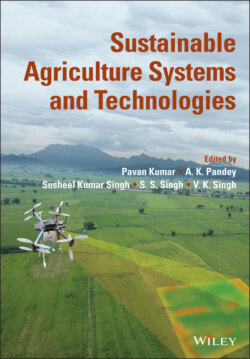Читать книгу Sustainable Agriculture Systems and Technologies - Группа авторов - Страница 21
1.3.1 Trends Over Time
ОглавлениеThe performance of the states over two National Family Health Survey (NFHS) reveals that the situation has improved over the years in most of the cases (Figure 1.3). NFHS 3 conducted in 2005–2006 and NFHS 4 conducted in 2015–2016 although not strictly comparable, have substantial results to show. The reduction in percentage of children who are stunted was highest in Arunachal Pradesh (32%), Tripura was followed by Himachal Pradesh and Punjab. It is noteworthy that Tripura, Himachal Pradesh, and Punjab are among the top five states with the least percentage of stunted children. While Uttar Pradesh, Madhya Pradesh, and Jharkhand could not make substantial efforts to reduce the stunted children percentage and remain at the top five states with the highest percentage of stunted children. In case of child wasting, the results have been striking. Meghalaya, Mizoram, and Tripura have shown the highest level of reduction in percentage of population wasted, while increase in child wasting has been observed in Orissa, Haryana, Andhra Pradesh, Chhattisgarh, West Bengal, Uttar Pradesh, Assam, Gujarat Sikkim, Karnataka, Maharashtra, Goa, and Punjab with highest increase in the percentage. Madhya Pradesh has reduced by 26% indicating efforts done by the government. Despite this fact Madhya Pradesh, Jharkhand, Gujarat, Karnataka, and Maharashtra have higher percentage than the national average. Child underweight situation means weight‐to‐age situation Mizoram has reduced by 39% and is the state with the least percentage of underweight children. Under‐five infant mortality again is highest in Madhya Pradesh, Jharkhand although Madhya Pradesh has reduced it by 30% but the highest decrease of 62% was witnessed in Arunachal Pradesh.
Figure 1.3 Trend of undernutrition over time in India 2005–2006 vs 2015–2016.
Average Annual Rate of Reduction – It is the average relative percentage decrease per year in prevalence or rate (WHO). A positive sign indicated reduction in the prevalence and negative sign indicates increase in the prevalence. It is calculated by the formula:
where Y t + n is the prevalence of the next year, Y t is the prevalence of the given year, and b% is the annual rate of reduction (UNICEF 2015).
The calculation of Average Annual Rate of Return revealed that the AARR of stunting in India is 2.2% which means till 2030 the prevalence will be reduced up to 33% if the situation remains same. This is a positive pace but slower in speed because the target of SDG is to reduce the stunting prevalence by 50% by 2030 from the level of 2012. The AARR of wasting (Table 1.2) shows that there are states like Arunachal Pradesh, Tripura, Himachal Pradesh, Punjab, Mizoram, Chhattisgarh, West Bengal, and Nagaland which have an AARR of more than 3%. These states will reach around 50% reduction by 2030. But at the same time, states like, Bihar, Tamil Nadu, Madhya Pradesh, Rajasthan, and Jharkhand have AARR lower than 1.5% which brings down the national average and makes reaching the SDG target tough.
In conclusion, we can say that the most vulnerable states in terms of hunger security are Madhya Pradesh, Uttar Pradesh, Jharkhand, and Bihar. The states which have performed well in reducing the prevalence are Tripura and Himachal Pradesh. Both the states have least prevalence of hunger. Giving us a lesson, although centrally sponsored schemes are there, still regional disparity makes the difference. States with higher dependence on agriculture and tribal population have higher level of hunger, indicating unequal income distribution and lack of improvement in influencing factors.
